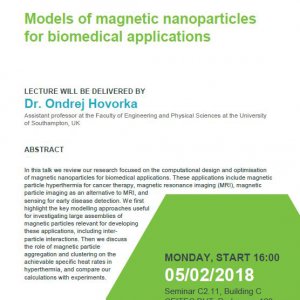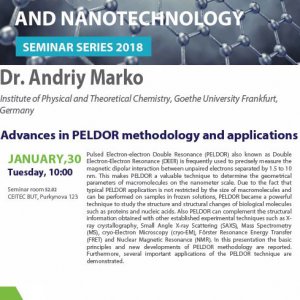
| Phone: |
+420 54949 4167 |
| E-mail: |
,
|
| Office: |
|
Research areas
-
Interactions of natural and chemically modified biopolymers with electrodes, relationships between biopolymer structure and its electrochemical, interfacial and electrocatalytic properties
-
Novel techniques in biopolymer labelling
-
Effects of DNA and/or protein chemical modification on the biopolymer molecular recognition features
-
Development of novel bioanalytical/bioelectroanalytical and diagnostic tools
Main objectives
-
Investigations into the behaviour of natural and chemically modified biomacromolecules at electrically charged surfaces linked to the development of novel electrochemical biosensors and bioassays.
-
Development of novel electrochemical biosensors, bioassays and diagnostic approaches.
CONTENT OF RESEARCH
Nucleic acids and proteins are electrochemically active species due to the presence of reducible or oxidizable moieties (nucleobases, side groups of some amino acids). In addition to intrinsic biopolymer responses, electroactive markers have been utilized to obtain reversible electrode processes at less extreme potentials than those produced by DNA or protein itself. Electrochemical detection has been utilized for various analytical applications, including detection of DNA damage, sequence-specific DNA sensing, probing DNA interactions with drugs, etc. Considerable progress has also been achieved in the development of novel ways of working (detection) electrodes applicable in the area of biopolymer sensing. Recent literature reflects a remarkable boom in the development of electrochemical biosensors and bioassays, with a considerable contribution by the group. However, in contrast to a huge number of studies utilizing simple (e.g. oligonucleotide) models for the development of DNA sensors and testing their performance, studies demonstrating applications of electrochemical sensing on more “real” systems (such as large DNA or protein molecules) are still rather scarce.
Interactions of nucleic acids, proteins and their components with/at electrically charged surfaces will be studied in detail with respect to nucleotide/aminoacid composition/sequence, secondary, tertiary or higher-order structures. We will focus on elucidating the mechanisms of structural changes in the surface-confined biopolymers (DNA unwinding, the formation of non-B DNA structures, protein folding/unfolding) on applying an external electric field, as well as on the characterization of the surface structure and electric field effects on the interaction between a surface-confined molecule and its counterpart in solution.
Novel techniques of biopolymer labelling will be developed to design novel bioanalytical and diagnostic tools. We will use various techniques, including enzymatic incorporation of labelled nucleotides into nucleic acids using enzymes and direct chemical modification of natural nucleic acids and their synthetic analogues using oxoosmium complexes. Modified nucleic acids will be studied in detail concerning the effects of sitespecific, terminal or global modification on their molecular recognition features (such as DNA hybridization, mismatch sensitivity, protein-DNA recognition). Sensitive electrochemical or other detection techniques will be developed using label-specific analytical signals.

Overview of enzymatic synthesis of modified DNA
CURRENT RESEARCH INFRASTRUCTURE
The research group is currently equipped with, or has access to, standard facilities for bacterial and cell culturing, nucleic and protein isolation, purification and characterization, performing biochemical studies of DNA structure and DNA-protein interactions (cultivators, biohazard box, deep freezer, centrifuges, FPLC, electrophoreses, phosphorimager, documentation systems, PCR cycler, etc.). Equipment currently available for electrochemical analysis and surface characterization (multimode electrochemical analyzers, electrode systems) needs to be upgraded and expanded to allow the expansion of the group’s research at CEITEC.
1. Behaviour of alternative DNA structures at electrically charged surfaces
Supervisor: doc. RNDr. Miroslav Fojta, CSc.
Annotation:
Electrochemical techniques have been established as sensitive tools for the analysis of nucleic acids structure, suitable not only for discrimination between „native“ (double-stranded) and „denatured“ (single-stranded) DNA, but also for sensitive detection of relatively subtle changes in the DNA conformation, DNA damage or interactions [1,2]. Recently, studies of the behaviour of alternative DNA structures such as guanine quadruplexes (G4) [3,4] appeared in the literature [5]. Recent results of the supervisor’s group [6] have indicated that the G4 formation remarkably influences electrochemical responses of relevant oligonucleotides (ON). Within this PhD thesis topic, a systematic study of electrochemical and adsorption/desorption properties of ON involving G-rich segments, suitable for G4 formation, will be pursued. Sequences of the model ON will either derived from natural DNA elements (such as telomeric DNA repeats), or specifically designed for studies of particular phenomena (e.g., effects of the length and nucleobase composition of loops or tails flanking the G4-forming stretches on the structure stability and/or adsorption at the electrode surface). Effects of conditions such as ionic conditions, presence of selected G4-binding ligands etc., will be investigated. Electrochemical measurements will be complemented with CD spectroscopy and electrophoretic studies.
Keywords: DNA structures, DNA conformation, guanine quadruplexes, oligonucleotides, electrochemical techniques











